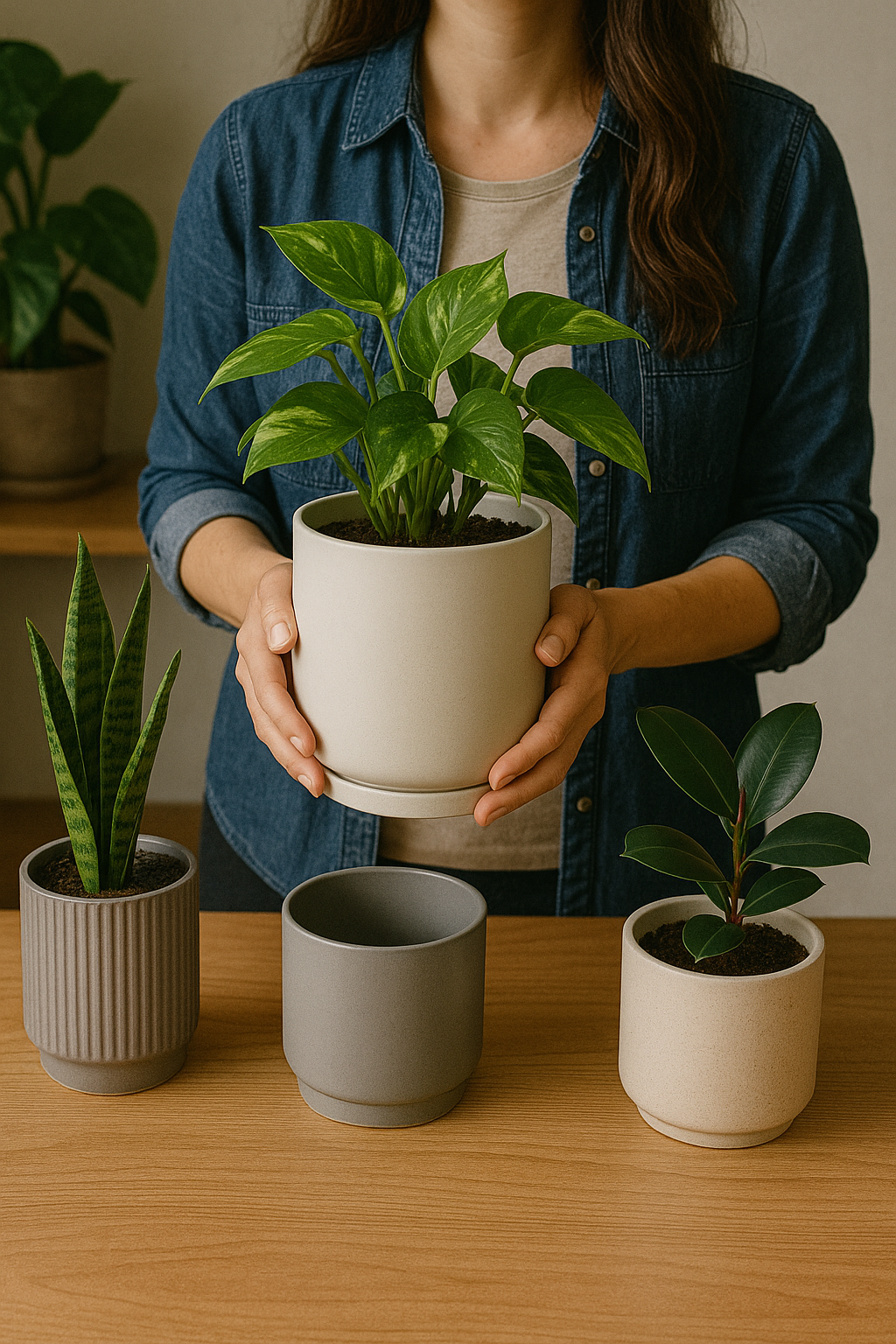Choosing a plant is only half the equation—the right pot can make all the difference between a thriving indoor jungle and a struggling houseplant. In apartment gardening, where space is limited and functionality matters, picking the right container is just as important as sunlight and watering.
In this article, you’ll learn how to select the best pots for your apartment plants based on drainage, material, size, and design—balancing both plant health and home aesthetics.
Why the Pot Matters
A plant’s pot affects its growth, water retention, airflow, and overall health. A poor pot choice can lead to common problems like root rot, stunted growth, or nutrient deficiency—especially in small apartments where environmental conditions may be more extreme.
Beyond function, your pot also plays a role in your interior design. A well-chosen container can complement your decor, add texture or color, and turn your plant into a true statement piece.
Key Features to Consider When Choosing a Pot
1. Drainage Holes
If there’s one rule all plant parents should live by, it’s this: Always choose pots with drainage holes. These small openings allow excess water to escape, preventing the roots from sitting in water and developing rot.
No drainage holes? You still have options:
- Use a cachepot: Place your plant in a plastic nursery pot with holes and set it inside a decorative container.
- Add a layer of stones at the bottom of the pot (less effective but better than nothing).
- Water more carefully, using a moisture meter to avoid overwatering.
2. Pot Size
Using the right pot size helps your plant establish strong roots without becoming waterlogged or root-bound.
- A pot that’s too small will dry out quickly and restrict growth.
- A pot that’s too large may hold excess moisture and lead to fungal problems.
Rule of thumb: When repotting, choose a new pot that’s 1 to 2 inches (2.5 to 5 cm) larger in diameter than the current one.
3. Material
Each material has its pros and cons. Here’s a breakdown of the most common options for apartment gardeners:
Terracotta (Clay Pots)
- Pros: Porous, allows airflow to roots, rustic look.
- Cons: Dries out faster, heavier, can crack in cold conditions.
Ceramic Pots
- Pros: Beautiful finishes, good for design, retains moisture.
- Cons: Heavier, often lacks drainage unless bought with a hole.
Plastic Pots
- Pros: Lightweight, inexpensive, moisture-retentive.
- Cons: Less breathable, may crack over time with sun exposure.
Fabric Pots
- Pros: Promotes air pruning of roots, lightweight, collapsible.
- Cons: Dries out quickly, not ideal for decorative purposes.
Metal or Concrete
- Pros: Durable and modern.
- Cons: Can overheat or be too heavy for shelves and hanging displays.
Choose your pot material based on the plant’s needs, your lifestyle (e.g., how often you water), and where the pot will be placed.
Pots for Small Apartment Spaces
When you’re short on space, the right container setup can help you maximize your greenery without adding clutter.
Hanging Planters
Ideal for trailing plants like pothos, spider plants, or string of hearts. Free up floor and shelf space while adding greenery at eye level.
Wall-Mounted Pots
Use vertical space for herbs or decorative plants—just ensure secure mounting and water protection for walls.
Windowsill Containers
Narrow planters or herb troughs are perfect for small, sunny ledges in kitchens or living rooms.
Stackable Planters
Vertical planters with multiple tiers allow you to grow several plants in the footprint of one.
Shelf-Friendly Pots
Lightweight, compact containers that fit neatly on floating shelves or bookcases help create a mini indoor jungle without overwhelming the space.
Matching Plants to Pots
Choosing the best pot also depends on your plant’s specific needs. Here are a few common pairings:
- Succulents & Cacti: Terracotta pots are ideal because they help soil dry faster.
- Ferns & Calatheas: Ceramic pots retain moisture better, keeping humidity-loving plants happy.
- Snake Plant & ZZ Plant: Thrive in plastic or ceramic with moderate watering.
- Orchids: Prefer clear pots with slits for airflow around their roots.
Also consider the weight of the plant + pot combo. If you plan to move your plants around or place them on shelves, opt for lightweight options.
Decorative Tips for Pots in Apartments
Pots aren’t just practical—they’re part of your interior design. Here’s how to use them creatively:
- Mix sizes and textures: Use different shapes and finishes to add visual interest.
- Stick to a color palette: For a modern or minimalist look, use black, white, and neutral-toned pots.
- Group in odd numbers: Arrange your plants in groups of three or five for a natural look.
- Use risers or stands: Elevate some pots to add layers and dimension.
If you’re tight on budget, repurpose containers like mugs, tins, or baskets—just make sure to address drainage.
What to Avoid When Choosing a Pot
- Sealed containers without drainage: These can lead to root rot if you’re not extremely careful with watering.
- Pots that are too heavy for shelves: Always consider safety and the weight limit of furniture.
- Overly large pots for small plants: They can hold too much water and overwhelm the root system.
- Dark metal pots in sunny spots: These can heat up quickly and damage roots.
Final Thoughts: Pot Smart, Grow Happy
Choosing the right pot for your apartment plants isn’t just about aesthetics—it’s a crucial part of good plant care. With the right size, material, and placement, you’re setting your plants up for long-term success in a limited-space environment.
Whether you’re working with one windowsill or an entire wall of greenery, the right container can elevate your space and keep your plants thriving. Think of it as the foundation of your indoor garden—simple, stylish, and essential.
